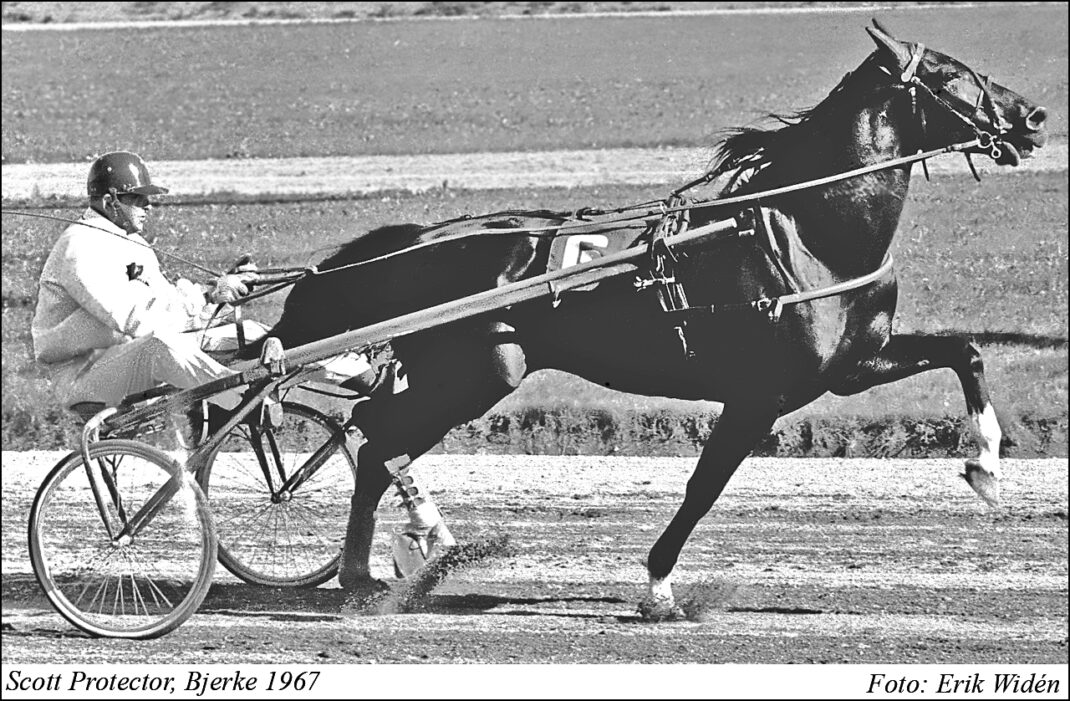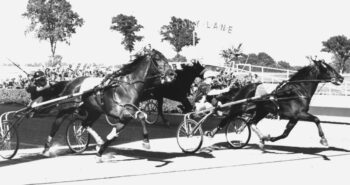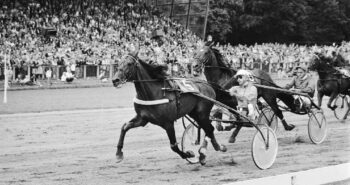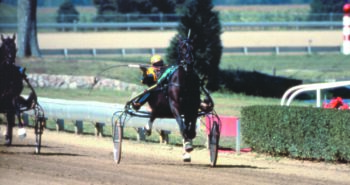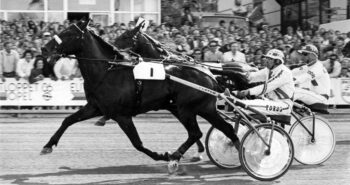He was one of Norway and Scandinavia’s best trotters for years and hailed from an exceptional group of siblings that included several elite trotters. Though described as “the most intelligent trotter I have ever dealt with”, Scott Protector could be grouchy and a handful at times. Regardless, he was an excellent trotter – and when that wasn’t enough, his trainer employed team tactics against the opposition.
When Otto Madsen imported the 14-year old Elsie Scott 2:10 (1.20,8) – a full sister to Rose Scott and Scotland – to Norway in 1935, he couldn’t possibly realize the massive impact she would have. The mare had 7 foals in Norway, all started an all were winners. Two finished second in the Norwegian Derby; Marie Mcelwyn in 1939 and Kinney Spencer in 1942. Then three of her daughters produced a Derby winner; Spenda in 1954, McKinney Boy in 1957 and Scott Protector in 1965. The latter was a son of Marion Ford, one of the best broodmares in Norwegian trotting history. Marion Ford, a daughter of the blind champion stallion Senator Ford, had 11 foals, of which 10 were starters and winners. Four of these were among Norway’s best trotters in the 50s and 60s. As an aside, before export Elsie Scott had two daughters in the US. One of these, Elsie Truax, left a massive legacy on the pacing side with big names such as No Nukes, Rock N Roll Heaven, Clear Vision, Silent Swing and Mel Mara tracing back to her on the maternal line.
A good young trotter, but needing a bit of time to fully come into his own, Scott Protector finished fifth in his career debut as a three-year-old in May 1964, but it didn’t take the colt long to start winning. When the Kriterium, the biggest race for 3-year-olds in Norway, came around he finished third. Next year, he finished second behind Olympic Champion in the Jarlsberg Grand Prix but when Derby time came around in September he won easily. At 5 he was already the dominant aged trotter in Norway and, the few times he crossed the border, also in Sweden.
Although he didn’t lack speed, Scott Protector was still a very strong horse and more suited to slightly longer distances, also because he lacked gate speed. He was also a temperamental horse, not always easy to be around, and wore both ear plugs and also a thick ear hood. Karsten Buer, his trainer, remarked that the horse knew exactly what he wanted and had his quirks. If a veterinary came into the barn wearing a white coat, all hell broke loose in Scott Protector’s stall. Gunnar Eggen, the Norwegian champion trainer who worked with Karsten Buer early in his career, later described Scott Protector as a “grouch.” But regardless of his bad temper, supposedly from the maternal family according to Eggen, he was nonetheless a very impressive trotter.
An elite trotter
In July 1966, Scott Protector and Olympic Champion represented Norway in the European Championship for 5-year-olds, that year held in Copenhagen, where they finished second and third behind the German trotter Vinci. In September Scott Protector went to Solvalla for the Nordic Championship. Karsten Buer would later describe it as one of the best races he ever drove. Leaving from post 1, after a tough opening, Scott Protector was ideally positioned second over behind the Swedish favorite Xanthe while another Swede, Pecka Trickson, held the lead. But instead of sitting quietly, Buer made a surprise attack with a lap to go, flew the lead and kept a high tempo, in the end winning by two lengths ahead of Xanthe.
In the Nordic Championship for 5-year-olds two months later he went off-stride but still finished third. Just a month later, in October 1966, Scott Protector and Karsten Buer won the newly created Oslo Grand Prix, then a two heat race. Paradoxically Scott Protector won the mile long heat but finishes second in the 2100 meter (1 5/16 mile) heat. Instead of a trip in November to the big Elite-Rennen in Gelsenkirchen, Germany, where the horse was invited, Scott Protector was given a winter break after 11 seasonal wins.
The next year Xanthe got his revenge in the Oslo Grand Prix and Scott Protector had to settle for second place, but he still won the Axel Jensens race in Norway and Juliloppet and Gösta Bergengrens Minneslopp in Sweden. He was also invited to the International Trot. The race did not suit Scott Protector at all as French mare Roquepine was going very slow in the lead – too slow according to many – and it turned into a speed race in the last turn, something which did not fit the Norwegian trotter well. Buer later wrote in his book that he probably made a mistake by not attacking with a lap to go when Oscar RL was moving up on the outside but he was very cautious against so many big names. The decision proved fateful as Scott Protector was boxed in for too long. The week after he almost got his revenge, though, in his division of the Challenge Cup with a second place.
At 7, in 1968, he kept up his winning ways in Sweden, taking home the prestigious Årjängs Stora Sprinterlopp in two heats, defeating the Swedish imported French born Train Bloc in both heats, and also winning the Midsommarloppet and Harald Westlins Minneslopp. In the Nordic Championship, contested in Copenhagen that year, the trio representing Norway were Scott Protector, his full brother Lloyd Protector and their sister Tove Bulwark – three siblings all out of the fantastic broodmare Marion Ford. Additionally, Tove Bulwark’s older full brother His Son, by Khedive, had been a very good trotter some years prior.
The team effort
But despite Scott Protector’s strength and ability to do everything by himself when necessary he didn’t always do it all entirely by himself. When Scott Protector won the Jubileumsløpet (“the Commemorative race”) at Bjerke in 1966 it was truly a team effort (!). The race was, as was common back then, a two-heat race over different distances. Scott Protector had a 20 meter handicap behind most other trotters including Blazing Love with Håkan Wallner who visited from Sweden. As Wallner and Blazing Love was allowed to control everything in mile-long race with Scott Protector third a long distance behind, all hell broke loose in the stables. “Here I have three horses from the same owner, and no help anywhere” yelled Karsten Buer.
Giving clear orders for the 2100 meter (1 5/16th) mile race, Tove Bulwark – Scott Protector’s sister and herself a top trotter – was to be sacrificed. The third trotter from the same owner, Lloyd Protector – Scott’s one year older full brother and also an elite trotter – was too slow out of the gate to be part of the plan. Blazing Love went to the lead and immediately Tove Bulwark was all over him, putting immense pressure on the Swedish trotter. Half-way through Tove started to fade, slowing down to a slow jog. Fortunately, another Norwegian horse came to the rescue. Gunnar Diskerud’s Rolls Royal had been disqualified in the first heat and had nothing to lose anyway. Diskerud realized what was going on and sent his horse forward, sacrificing his own horse’s chance in order to crush the Swedish guest. Going into the final turn Scott Protector went to the lead while Blazing Love hit the wall completely. According to one of Buer’s stablehands, it was a complete collapse. Blazing Love was completely empty and slowed down to a walk – even Tove Bulwark passed him in the final stretch.
Counting the laps
Buer later told a story that illustrated Scott Protector’s intelligence. He would usually train the younger and weaker horses first, always leaving Scott Protector until the end. He always trained 4 kilometers, i.e. 4 laps around Bjerke’s 5/8th oval. After having trained all the other horses in his stable, Buer’s mind would, by his own admission, occasionally wander a bit. But if he tried to direct the horse back to the stable after only 3 laps his star pupil would ignore the instruction and run the fourth lap, similarly if he forgot to turn off the track after 4 laps, Scott would do it by himself. The horse counted laps and Buer soon realized that could trust the horse entirely as he never got it wrong. When the colt had been away from the track for 6 months due to injury, Buer decided to test him and did not give the horse any instructions to slow down and exit the track after 4 laps. It didn’t matter though, because Scott Protector still counted the laps and exited the track exactly when he was supposed to.
Struggling with his feet for a period, he came back at 10 to yet again win the Axel Jensen Trot at Bjerke/Oslo and the Årjängs Stora Sprinterlopp in Sweden. He ran his last race Dec 17, 1961, the mandatory retirement age in Norway prohibiting him from racing past the age of 12. Befitting of a king, he won his last race, too. He retired to stud and produced several good trotters, though mostly late bloomers and none close to his own abilities.
Scott Protector died in April 1984, and was buried at Bjerke Travbane in Oslo.
Scott Protector
Black colt born in Norway in 1961. Died in Mysen, Norway on Apr 7, 1984.
Saint Protector – Marion Ford (Senator Ford)
191 starts: 116-37-? – Fastest time: 1.17,2 (2:04.1f) – Fastest win: 1.17,3 (2:04.2f) – 837,342 NOK
Breeders: Elsa & Asbjørn Jensen
Owners: Elsa & Asbjørn Jensen
Trainer: Karsten Buer
Drivers: Karsten Buer and Gunnar Eggen
Grooms: Gunnar Eggen and Kristian Olsen

